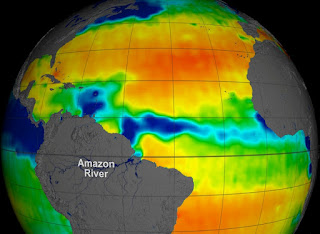Oxygen Levels In Earth's Atmosphere: Fluctuated Wildly Over a Billion Years Ago
Oxygen levels in Earth's atmosphere fluctuated wildly over a billion years ago. Researchers say this created conditions that could have accelerated the development of early animals.
Scientists believe that oxygen in the atmosphere evolved in three stages during what is known as the Great Oxidation Event two billion years ago. During the third phase, about 400 million years ago, oxygen in the atmosphere increased to today's levels.
What happened during the second phase, known as the Neo Proterozoic Era, is uncertain. It started about a billion years ago. Lasted about 500 million years, during which the earliest forms of animal life emerged.
The question the scientists tried to answer was was there anything unusual about the changes in oxygen levels during the Neoproterozoic era? This may have played a key role in the early evolution of animals- did oxygen levels rise suddenly or was there a gradual increase?
Fossil traces of early animals known as the Ediacaran biota were multicellular organisms that needed oxygen. Found in sedimentary rocks 541 to 635 million years old.

A research team at the University of Leeds used measurements of different forms of carbon and carbon isotopes found in limestone rocks taken from shallow seas to allow researchers to calculate levels of photosynthesis millions of years ago and infer atmospheric oxygen levels based on the isotope ratios of different types of carbon founds.
As a result of the calculations they were able to produce a record of atmospheric oxygen levels over the past 1.5 billion years. This tells us how much oxygen diffused into the ocean to support early marine life.
Lead scientist on the project is Dr Alex Cross, a biogeochemical modeller who completed his PhD at the School of Earth and Environment in Leeds. According to Dr. Alex Krause, the research provides a new perspective on how oxygen levels on Earth changed, suggesting that the early Earth was without anoxic atmospheric oxygen for the first two billion years of its existence. Then the oxygen levels started to rise. This is called the Great Oxidation Event. Until now scientists have assumed that oxygen levels were low before we saw the first animals evolve after the Great Oxidation Event, or that oxygen levels were high for many millions of years before animals arrived. But our study shows that different source. There was an oscillation between high and low levels oxygen long before the earliest forms of animal life emerged. We are looking at periods of marine environments where early animals lived. There is plenty of oxygen and then there are periods without it.
This periodic change in environmental conditions produces evolutionary pressures that cause some species to die out and new ones to emerge. Oxygenated periods spanned what are known as habitats, parts of the ocean where oxygen levels were high enough to support early animal life forms. Ecological theory proposes that when you have an expanding and contracting habitable space, this contributes to rapid changes in the diversity of biological life. Dr Benjamin Mills, who leads the Earth Evolution Modeling Group at Leeds and oversaw the project, said:
Certain organisms are under severe environmental stress when oxygen levels decline. These can drive extinctions, and when oxygen-rich waters expand, new space allows survivors to rise to ecological dominance.
These extended habitable spaces last for millions of years, giving ecosystems plenty of time to develop.
Story Source:
Materials provided by the University of Leeds.
Note: Content has also been changed for vogue and length.
Know The Age of Earth
Visit Official Home Page





0 Comments